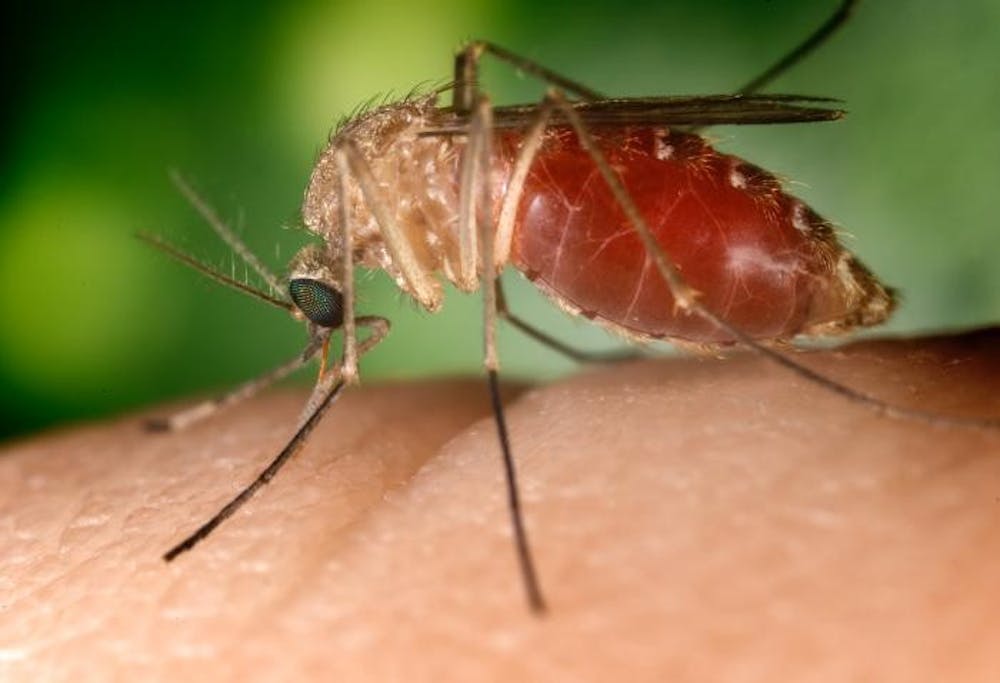As rainy summer weather occurs across the United States, students and faculty returning to Charlottesville from summer travels should keep the potential health risks associated with mosquitoes in mind. Rainwater collected in puddles and outdoor receptacles can provide water sources for mosquitos, which lay their eggs in stagnant water.
In addition to diseases such as Zika, one notable mosquito-borne illness is West Nile Virus. WNV is most commonly spread to people through the bite of a mosquito that feeds on WNV-infected birds.
According to the Centers for Disease Control and Prevention, cases of WNV peak during mosquito season — which lasts throughout the summer and fall. Mosquitoes across the state of New York have tested positive for WNV, and numerous states — including Virginia — have reported WNV infections in humans to the CDC this year.
No vaccines exist to prevent WNV and no medications exist to treat the virus in humans. Only one in five infected people show signs of illness and may develop symptoms ranging from a fever and body aches to inflammation of the brain and spinal cord.
David Gaines, a State Public Health entomologist at the Virginia Department of Health, said there are about 60 species of mosquitoes found in Virginia and about half those species reside in or around the Charlottesville area.
Culex pipiens, Aedes albopictus, Aedes triseriatus and Aedes vexans are four species found in Virginia that he said are of increased public health importance because they could potentially carry and transmit WNV.
He said that while he was involved in mosquito surveys in Charlottesville between the years 2002 through 2006, he is unsure of Charlottesville’s WNV status this year.
“Back in those days, we did occasionally detect WNV-infected mosquitoes during our Charlottesville surveillance activity,” Gaines said. “They were always the Culex pipiens and the Culex restuans species.”
He said that in Virginia, there is no state money currently allocated for mosquito control or surveillance and larger-scale mosquito control programs are only seen in the very wealthy counties that regularly see human cases of WNV — such as Fairfax or Prince William County — or in heavily-populated counties that experience outbreaks of floodwater mosquito species.
Prior to this year, he noted that only one case of WNV has been identified in the area of Charlottesville and Albemarle County.
That case was seen in a person who had travelled to another WNV endemic area in Texas beforehand. Gaines said that while transmission of WNV to people is possible in the Charlottesville area, he has no knowledge of it occurring yet. Instead, he said that WNV transmission is present is surrounding areas.
“The nearest place to Charlottesville where we have seen local WNV transmission to people has been in Greene County — somewhat close to where there is a sewage treatment plant — and in the agricultural sectors of the Shenandoah Valley where there is a lot of livestock production,” Gaines said.
He said that all species of mosquitoes go through seven stages of life including an egg stage, four larval stages, a pupal stage and an adult stage. The immature larval and pupal stages of each mosquito species occupy specific aquatic habitats.
Culex pipiens larvae specifically occupy water with high organic content such as stagnant water in storm sewer pipes, unused sewage treatment plant tanks and water that contain some animal manure or dead leaves. He said that Aedes albopictus and Aedes triseriatus — commonly known as Asian tiger mosquitoes and Eastern treehole mosquitoes — are only found in unpolluted artificial or natural containers of water while inland floodwater mosquitoes are found mostly in rainwater puddles.
Dr. Anjali Silva, an Elson Student Health staff physician, recommended students practice habitat avoidance on the areas where mosquitoes live. She also recognized areas with standing or stagnant water — such as ones in backyards — as places to avoid and suggested emptying collections of water on properties that mosquitoes could inhabit.
She said that different types of mosquitoes cause different diseases and bite at different times of the day.
“The Culex mosquito that carries West Nile Virus tends to bite from dusk to dawn,” Silva said. “It would be important to be indoors at this time or at least behind screens.”
Aside from protective clothing such as long pants and long-sleeved tops, she also recommended that clothing and camping equipment be sprayed with an insecticide called permethrin that can last through several washings without losing effectiveness. Additionally, insect repellent can be used on exposed skin.
“The best products are extended-release liposomal formulations of DEET, which can last up to 12 hours, or picaridin, which doesn’t damage plastics and delicate fabrics like DEET can,” Silva said.
She suggested not using products that combine insect repellent properties with sun protection because they tend to not be effective for protection from either. Instead, she advised applying sunscreen first and then insect repellent over skin.
In the most recent Virginia Department of Health Arbovirus Case Report in 2015, Charlottesville and the surrounding Albemarle area had no confirmed or probable cases of WNV.
Fortunately, while this year’s predominance of WNV transmission remains unknown in Charlottesville, the CDC states that only 1 out of 150 people who are infected develop a more serious WNV illness that can be fatal.







